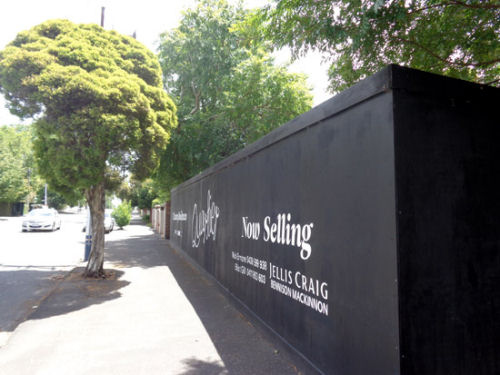
Article by Sheila Newman and James Sinnamon.
Absence of choice hallmark of Big Population

The tone is dictatorial: You will have a Big Australia. It will be perhaps 48.3m in 45 years. Nowhere in the article is anyone saying who decided to allow such high immigration or questioning the events leading up to this - certainly not the current Australians or those of 20 to 40 years ago. It is as if the author, who is the Melbourne Bureau Chief for the Australian Financial Review knows about some change afoot that the rest of us don't suspect; perhaps something violent that will stop dead any revolt as more and more Australians realise what they are being herded towards.
Aztec-like traditions
Aztec-like, the article harbingers the elites' desired crammed Australia with a symbolic child sacrifice, Alexander Marshall of Malvern East. As with the best traditional victims, Alexander, who looks about 5 years old, has no say in his fate. Innocence is what the gods and the elites require. Alex's appearance as a star on the elite-media altar that is the Australian Financial Review will be all too brief. Soon, through the aging process, he will look different from his photograph here. If the elites who drive the big financial markets and Australia's distant governments have their way, Alexander will gradually fade into an ever growing crowd of Australians suffering shortages of vital resources and competing with a stream of foreign born students and workers who will, by that time, have completely overwhelmed Alex's contemporaries. With immigration 60 per cent of Australia's population growth now and if the anticipated population of 48.3 (or more) actually happens, most of those people will be a foreign born selection-weighted for their ability to out-compete the natives in housing, income, position and status.
The infill process

Alex's suburb, Malvern East, will be unrecognisable, well before he reaches fifty, for Malvern East is doomed by planners to 'high densification', part of the plan to cram in that 48.3m and the next 48.3m and the ones after those. This old suburb, with its spacious and ornate wooden houses (all that is left of once vast forests nearby), its broad-leafed plane trees on every street, is already pocked with moonscaped sites and notices announcing twelve new units for a single block.
Scapegoating the elderly
The article pretends, "That people can expect to live longer than any other period in history is a main driver of this population increase." In reality it is out-of-proportion mass immigration that is clearly driving Australia's overpopulation. Ironically, that immigration, far from keeping the population youthful, is actually increasing the rate of aging. The article uses the old fallacy that we need many migrants to care for our hugely aging population, without ever admitting - does the writer even realise? that past immigration contributes more aged to our population than the native-born? See "Immigration speeds up Australia's rate of aging - FECCA" and High post-war immigration blamed for today's economic problems.
For a completely different way to manage the needs of our population and economy, see: "Discussing Australia's Dependency ratio 2009 with graph by Dr Katharine Betts".
Scapegoating outer-suburbanites and the disabled
Another hallmark of this typically growthist article is its scapegoating of certain classes. Scapegoats include those who live at a distance from the CBD away from major transport routes. They are portrayed as costing the rest of us for infrastructure, however elsewhere, the article acknowledges that population growth is driving housing unaffordability and thus pushing people outwards to cheaper lots. (High density inner suburbs also need lots of infrastructure - consider the proposed and already hated East-West Link. High-rise use more fuel to run than houses.) The aged, of course, are accused of being the reason that we must all submit to our 'demographic destiny'.
The AFR beats the ageist drum, beginning the article by evoking how a tram has to wait while a 70 year old man with a prosthetic leg slowly mounts it. "Getting drivers to wait for passengers to reach their seats is just one example of the changes we will have to make in the way we live and work if we are to cope with the massive population changes experts predict." The problems with this image and its conclusion are multiple. Firstly, people have long lived to 70 plus and had prosthetic limbs. (Remember Long John Silver?). Secondly, we are in a society that promotes independence for the disabled. Thirdly, and much more relevantly, has the author not noticed that women with prams and toddlers usually also cannot mount moving trams at a run. This is an example of the absurd lengths to which journalists, high and low, are expected to go to market the growthist message in Australia. They might as well be writing for real-estate agencies, but in fact they are. Both the Fairfax and Murdoch press are heavily invested in global marketing of Australian real-estate among their many other corporate interests. More and more of the pages of the Australian Financial Review these days are taken up with real-estate, property development, land-marketing, land-use planning arguments, and industries associated with immigration. This article by Dunckley is just one more example, a double-pager one, signifying that someone there thinks they have to step up the pace of propaganda.
Live AFR videos: Rebecca Thistleston tells of measures the Building Industry advocates the government adopt for a sufficient number of houses to cope with population growth to be built; Matt Starkey describes our future with more than double (48 million) our current population (23 million) by 2061 and 70 million by 2100.
Demographic mythology of the Growth Lobby
I have been reading articles like this one in the Australian press since the early 1990s, when I began to understand what was driving Australia's population growth in the face of manifest democratic disquiet. See The Growth Lobby in Australia and its Absence in France, which first identified what it is about our system and other Anglophone systems that makes it so hard to stop population growth when elites are driving it. For a short explanation of what the "Growth Lobby" is, see "How the growth lobby threatens Australia's future". I recently wrote a book, the result of ten years of independent work on population and economic theories, (S.M. Newman, Demography Territory and Law: The Rules of Animal and Human populations, Countershock Press, 2013.) I honestly know quite a lot about population and I can tell you that this article is a compendium of demographic mythology, thrown together to prop up a failing economy in the short-term, and throwing the rest of us to the wolves. The scale of population growth that this article is advocating is nothing short of an invasion.
Why it all makes sense
My attention was first drawn to Mathew Dunckley's article in the Financial Review by a number of people who are concerned about the consequences of overpopulation in Australia. A frequent remark was that it did not make economic sense to advocate a situation where democracy would be frankly reduced by crowding of electorates and an increasing number of people would face malnutrition, homelessness and disease. Why would anyone advocate such a situation? The answer seems to be that this situation benefits a few corporations and their investors. The banks want it, the property developers want it, the miners and building materials producers want it, and the newspapers want it. They want it because there is global economic decline and they have important investments in resources and commodities that benefit from increased demand. They know that increasing demand by driving up population growth will cause poverty and social dysfunction. But they don't care. Unlike the Australian, the Age, the Herald Sun, the Sydney Morning Herald or the Courier Mail etc., which all have the same agenda , the Australian Financial Review does not even pretend to care about 'democracy' or the 'people'.
Tourism vs Big Business - an example of the paradigm
Many people in Australia are worried about the effect of human population growth and infrastructure expansion on Australian wildlife and habitat. They often seek economic arguments to defend other creatures and the beauty of nature against people and forces that appear completely uninterested in anything but money. So these conservationists wonder why, for instance, koalas are being driven extinct through the rapid removal of their remaining patchy habitat. Why, they wonder, would the government damage local tourist industries by removing the very things that attract so many people to this country? This conundrum arises repeatedly. Indeed the native animal and wild spaces tourism is a huge and valuable source of income for many people in Australia, and particularly for those in rural areas. So, why would government policy be so much more inclined to destroy than to protect it? The answer is obvious to anyone except those who still believe that Australia's governments try to promote what is best for most Australians. Our governments are only interested in what is good for banks, property developers, and allied corporations. Our elites and their parliamentary servants have become quite distant from nature and reality. They have no feeling for their compatriots, only for their financial and political peers. They are not interested in local economies; they are probably against local self-sufficiency, cooperation and self-government. So, the senseless makes sense, in a way, if you are blinded by greed.

Comments
Anonymous (not verified)
Sun, 2014-01-05 09:39
Permalink
The attack on "NIMBYs"
"More and more of the pages of the Australian Financial Review these days are taken up with real-estate, property development, land-marketing, land-use planning arguments, and industries associated with immigration".
One group, vocal against the tide of high rates of population growth, are the vilified "NIMBYs"! While they may not mention the dreaded "p" word of population growth, or the "i" word for excessive immigration, they generally safely stick to "planning" schemes for their cities and suburbs.
A study by University of South Australia and University of New England researchers compared the approval rates for new housing developments across all Adelaide councils to find out how the city would cope with increases in population. It found that council approvals showed that for every 1 per cent increase in the average weekly earnings of a council's residents, there was a corresponding 2 per cent reduction in that council's new housing approval rate. In other words, the more affluent the residential areas, the more vocal the "NIMBYs" were! The more articulate no doubt are the long term residents who have the wisdom and perspective of years, and the community support to be vocal.
Academics are meant to be indifferent and objective, not endorse any lobby group. However, University of New England co-author, Mr Sorenson said that "There is a need for Adelaide to get over the hurdle of NIMBYism, or the maintenance of existing lifestyle at the expense of housing the population.''
The "hurdle" of NIMBYISM is stopping population growth, and housing growth! The residents actually want to maintain their lifestyles and housing quality, not go down the path of Victoria's deprivations, congestion and high costs of "solution" to excessive population growth!
Adelaide inner-city growth stifled by NIMBYs - report of 4 Jan 2014 at http://www.theaustralian.com.au/news/adelaide-innercity-growth-stifled-by-nimbys-report/story-e6frg6n6-1226794577026
What's insidious is the assumption that our population growth is natural and organic, in response to the number of families, economic health and an abundance of affordable natural resources. Our "projected" population growth is engineered by at least 60% of our growth from immigration, and is a government policy that needs to be questioned and challenged - democratically like any other!
Anonymous (not verified)
Sun, 2014-01-05 16:40
Permalink
Victoria's SurfCoast Torquay bowing to population pressure
Anonymous (not verified)
Sat, 2014-01-11 08:53
Permalink
Lack of entertainment for the masses - due to population growth
Anonymous (not verified)
Sun, 2014-01-12 10:45
Permalink
Rising crime is another cost of population growth
But while assaults in the CBD have only increased by 1 per cent in the past year, the rate of violence has started surging outside of Melbourne.
Geelong has become increasingly violent with a jump in assaults of 28 per cent since 2003, to 1848 reported cases.
Whittlesea is also on the rise with a 19 per cent increase in assaults - 1453 last year. Wyndham's assault rate has increased 20 per cent to 1227.
There is a strong correlation between increasing crime and population growth in Melbourne. One can't ignore the implications. There are stark wastelands of disenfranchised people, with no unifying culture and nothing to do.
The article in the Herald Sun: Scourge of violence spread from Melbourne's CBD at http://www.heraldsun.com.au/news/law-order/scourge-of-violence-spreads-from-melbournes-cbd/story-fni0fee2-1226799718151 .
It's very telling than that the crime wave is emanating from the growth "hot spots" and not from the stable, more secure and quiet inner suburbs, or protected neighbourhoods.
Assault hotspots for Victoria 2012-13
Rising crime and the cost of policing is another fallout of high rates of population growth!
Add comment